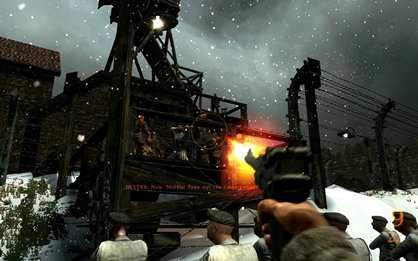GamesRadar+ Verdict
Pros
- +
Fun time-based mechanics
- +
Awesome futuristic weapons
- +
Satisfying old-fashioned guns
Cons
- -
Borrows more than a little from Call of Duty
- -
Wildly inconsistent difficulty
- -
Graphics look a bit dated
Why you can trust GamesRadar+
How would the Civil War have been different if you’d been there with a modern machine gun? I’ll tell you: It’d have been much more awesome. In Darkest of Days, you play as a 19th-century American soldier plucked out of his own time moments before becoming a casualty at General Custer’s Last Stand.

He’s then shanghaied into service for an organization of time travelers that specializes in maintaining the integrity of the timeline. His mission: to protect and extract certain important individuals who’ve been put in harm’s way by The Opposition, a time-traveling force that’s attempting to change the course of history. The twist: these interventions mostly occur during the Civil War Battle of Antietam and World War I’s Battle of Tannenberg - two of history’s bloodiest clashes.
DoD borrows more than a little from Call of Duty - like recharging health, scripted battles and legions of easily killed and dumb-as-clay-pigeon soldiers - but it also brings in a few ideas of its own. The main one is central to the plot: certain enemy troops, highlighted in blue, are meant to survive their war and therefore must be handled with non-lethal force to avoid tangling up the timeline. You can shoot them in the leg or the shoulder to bring them down alive, or toss a handful of marble-like devices called Chasers that track down and immobilize “survivors.” The presence of these enemies means you can’t just go for headshots or grenade everything in sight; you have to think a little more during combat. I wish they were a little more consistent, though, because sometimes you’ll go through most of a level without seeing a single survivor. I know the casualty rates in these conflicts were high, but not that high.
The majority of the levels are typical corridor shooter rail-rides, but DoD keeps things lively with open areas where you can choose the order you want to tackle objectives, turret defense segments, zeppelin rides, sniper missions (with an awesome high-tech sniper rifle) and more. There were a few problems like frustrating invisible walls and the inability to jump over waist-high wooden fences, but otherwise I thoroughly enjoyed most missions.

For about two-thirds of the game you’ll be armed with period weapons like the Civil War-era one-shot Springfield muskets, Henry repeating rifles and Colt revolvers, or WWI-era German Gewehr and Russian Nagant rifles, and Lugar and Mauser pistols. Every shot counts with these relics, since frequent reloading turns you into a sitting duck, making the game play differently from your typical run-and-gunner.
Getting accustomed to slow-firing weapons also has the bonus effect of making you feel like a total badass when the game hands you a futuristic assault rifle with auto-targeting and lets you loose on an entire formation of doomed-anyway Confederate soldiers. Most of the future weapons are great - and the last gun you get in particular, which I won’t spoil, is a viciously awesome weapon. It’s easy to go mad with power while wielding one; several times I ran into the open blasting away at the enemy only to find that a strong offense doesn’t necessarily eliminate the need for defense when vastly outnumbered and surrounded.

Which leads me to one of my chief criticisms. First, the difficulty is wildly inconsistent in places. While I was able to smoothly sail through most areas without dying (unless I did something stupid and totally deserved it), in others I felt completely screwed over by huge numbers of enemy troops and a lack of cover. This would have made me extremely angry at the stupid checkpoint-only save system, except that it seems to save every couple of minutes, so I never had to replay very far to get back to the trouble spots. As it is, I’m just a little angry at the stupid checkpoint-only saves.
Weekly digests, tales from the communities you love, and more
Another quibble: the graphics seem stuck in a time warp, lagging behind most big-budget shooters by a generation or two, particularly in the character model department. On the other hand, the large, cinematic environments often do a fantastic job of making you feel like part of a bigger historical battle, especially when dozens of soldiers crowd the screen at once and the air is thick with bullets and smoke.

Would Darkest of Days have benefited from another $10 million worth of development time for polishing and voice work improvements? Absolutely. But it makes the most of what it’s got, and it’s worth every penny of its modest asking price.
PC Gamer scores games on a percentage scale, which is rounded to the closest whole number to determine the GamesRadar score.
PCG Final Verdict: 80% (good)
Sep 16, 2009
More info
| Genre | Shooter |
| Description | Though the graphics aren't the best and it borrows much from CoD4, the inventive use of time travel makes this a pretty good single-player FPS. |
| Platform | "PC","Xbox 360" |
| US censor rating | "Mature","Mature" |
| UK censor rating | "18+","18+" |
| Release date | 1 January 1970 (US), 1 January 1970 (UK) |



